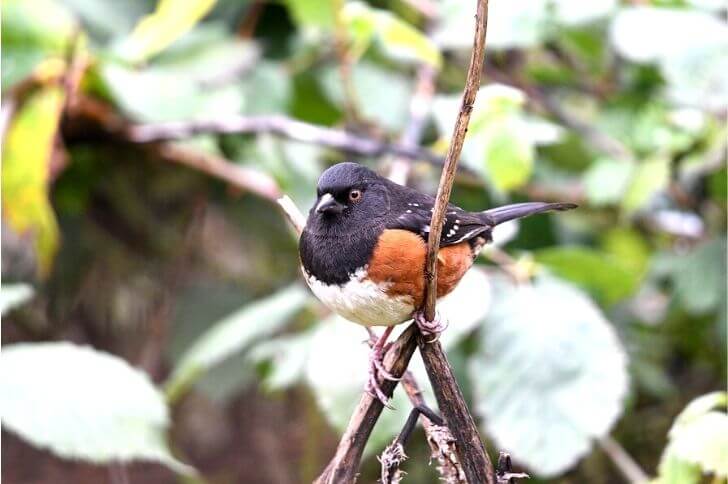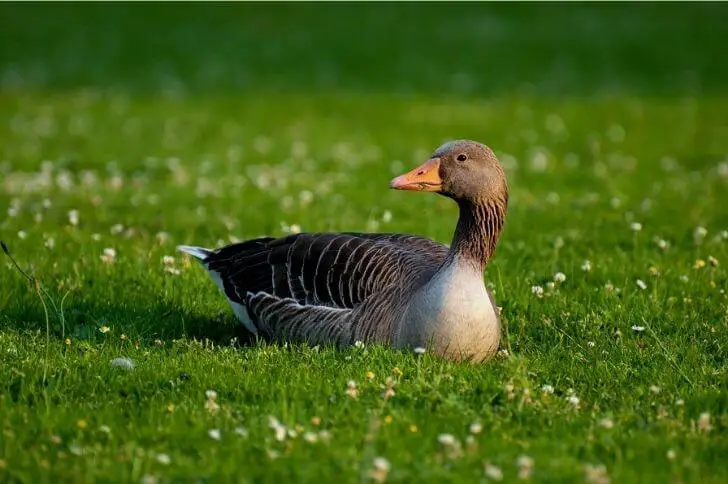One of the most interesting things about nature is the variety of animals that exist. Among these animals are black birds with long necks. These birds are not only interesting to look at, but they also have some unique behaviors. For example, the black swan is not only known for its graceful movements but also its low divorce rate.
Below we’ll look at other avian species that fit perfectly in this category of wild birds. If you want an interesting birding experience, read on.
List of Wild Birds with Long Necks
1. Black Heron

The heron family is made up of numerous birds. Some of the most popular members are the little blue heron, great blue heron, gray heron and purple heron. In this article we’ll look at a lesser known member of the Ardeidae family, the black heron.
Identification:
A black heron is a type of wading bird that can be found in marshes and wetlands of Africa. These birds are known for their long necks and legs, which they use to wade through water in search of food.
This black bird with long neck is about 22 inches in length with a height of 16.5-25.9 inches. Note the long plumes on its head.
Other facts:
Black herons are also known for their dark plumage, which helps them blend in with their surroundings.
These birds typically eat small fish, frogs, and insects. They will also occasionally eat larger prey, such as snakes or lizards. The black headed heron uses its sharp beak to impale its prey before swallowing it whole.
2. Muscovy Ducks
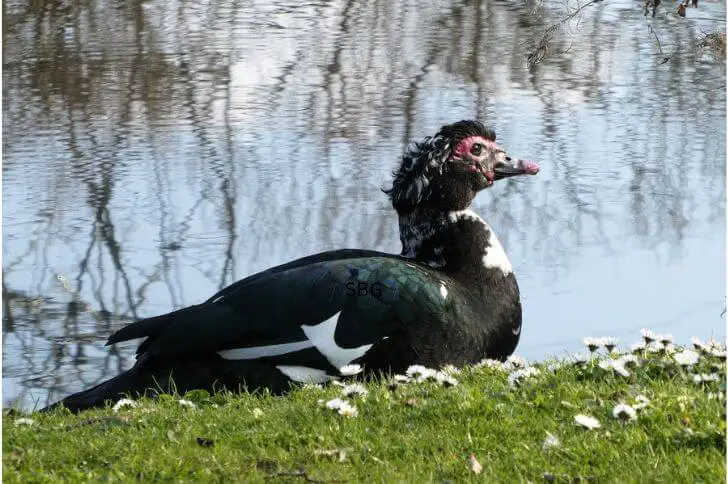
Are there black ducks with black necks? Yes, Muscovy ducks. This large species of duck is native to parts of North America, Central America, and Mexico. These ducks are some of the oldest domesticated ducks in this region.
Identification:
The ducks are known for their distinctive red facial caruncles and for their habit of perching in trees
It is one of the largest species of duck in the world. Males can weigh up to 15 pounds and females can weigh up to 8 pounds. The body length of muscovy ducks can range from 24-34 inches long. The wingspan of these birds can reach up to 5 feet wide!
Also males are black above and below with a white patch on the wings. Note the red patches on their face. Similarly, females are overall black but lack the red facial markings.
Other facts:
These black ducks with long necks are herbivores and primarily feed on aquatic plants, grasses, and fruits. They will also consume small insects, snails, and crustaceans. They breed up to three times a year, raising up to 15 babies each breeding season.
3. Australian Brushturkey

Planning to visit Australia? During your next bird watching trip to this incredible region, make sure to take a few pictures of this widespread species. Locally, it is known as the bush turkey or gweela.
Identification:
The bird is the only member of the genus Alectura. It is also one of the largest species of turkey in the world. An adult bird is 23-29.5 inches in length and can weigh up to 5 pounds.
The adult is all black and like all wild turkeys it spots a bald head and neck that gives it the red plumage. Note bright yellow neck wattle.
Other facts:
The bird gets its name from its habit of using its beak to rake through leaf litter in search of food. It is a ground nester, using the same site every year. Breeding season starts in September through March.
4. Ostrich

On your African safari, get sometime and visit ranches and game parks. Chances are you’ll come across these large and flightless birds with long necks.
Identification:
Large and unmistakable, ostriches can grow up to 9 feet tall and weigh over 350 pounds. Overall, the bird is all black with a naked neck and feet.
Speaking of feet, the ostrich’s feet are long and powerful, capable of reaching speeds of 40 miles an hour.
Other facts:
Does an ostrich fly? are not able to fly, but they can run very fast. Their wings are small, but they use them to help balance when they are running.
What do they eat? Mostly plants, but they will also eat insects and small animals. I also find their breeding habits quite interesting. Did you know their egg measures about 6 inches in length? Same size as a blue jay or robin bird? Sexes take turns incubating them.
5. Glossy Ibis

This list of black birds with long necks would be incomplete if we didn’t include the glossy ibis. An all-year resident in parts of Africa and Australia, this bird is unmistakable.
Identification:
The glossy ibis is a wading bird in the ibis and spoonbill family. It is a medium-sized bird with iridescent plumage. The body is black with a greenish sheen, and the head, shoulders and breast are dark brown. Like the tricolored heron, it spots a long and curved bill. Notice the long gray legs.
Other facts
These long legged birds breed in marshes, wet meadows, and mangrove swamps. The nest is a platform of twigs lined with leaves, grass, or feathers.
Both adults incubate the eggs and care for the young. The diet of the glossy ibis consists of insects, crustaceans, frogs, reptiles, small mammals, and berries.
6. Double-crested Cormorant
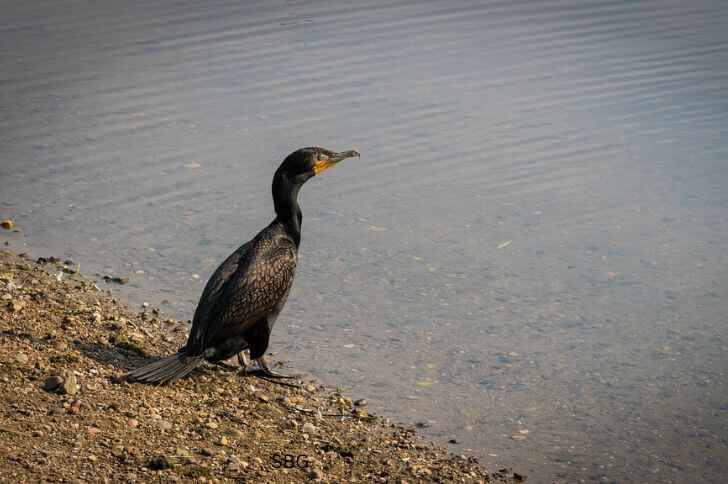
A resident breeder of the United States, these large long necked birds have a dragon-like look. They are closely related to the red-footed boobies and here is how you can identify them.
Identification:
The double-crested cormorant is a member of the Phalacrocoracidae family, and is one of the most widespread cormorants. It is a large-sized blackbird-like waterbird with a long neck, webbed feet, and a hooked bill.
The adult has stunning blue eyes and orange-yellow facial skin. The sexes are similar in appearance, but the female is usually smaller than the male. Juveniles are duller.
Other facts:
The double-crested cormorant is found in fresh, brackish, and saltwater habitats across North America. It is an opportunistic feeder that dives for fish, crustaceans, and other aquatic prey.
Other long necked birds of this species include the brandt’s cormorant, great cormorant, and pelagic cormorant.
Related: Check interesting birds in Northeastern United States
7. Anhinga

Anhinga, sometimes called snakebirds or American darters, are long-necked, fish-eating birds with sharp bills and webbed feet. They are found near freshwater marshes and swamps in the southeastern United States.
Identification:
This long necked bird is about 29.5-37.4 inches and spans 42.9 inches. Sexes are slightly different in plumage. Males are dark overall with prominent white streaks on the wings and back. Females also have a black body but sport a tan head and breast. Fledglings are similar to females.
Other facts:
Anhingas are excellent swimmers and divers. They often swim with only their necks and heads above water. When they spot a fish, they quickly dive underwater to catch it. In North America they are mostly found in Alabama and other southern states.
8. Black swan

One of the most remarkable wild birds with long necks is the black swan. A bird of the genus Cygnus, it is native to Australia. But, they are an introduced species in parts of the United States like Florida and California.
Identification:
Black swans are generally larger than other swan species and can grow up to 1.5 meters in length. They have long necks and legs and their wingspan can reach up to 6.6 ft. Black swans are mostly black with white underwings and a red bill. They are graceful birds that are known for their elegant swimming and flying abilities.
Other facts:
Black swans mate for life and build their nests near water sources such as lakes, rivers, or wetlands. They typically lay 4-6 eggs which hatch after about 35 days. Eggs are smaller compared to the ostrich eggs.
9. Black Guineafowl
Closely related to the gorgeous vulturine guineafowl, the black guineafowl is a black long-necked bird found in parts of Central Africa.
Identification:
These birds are about 17 inches in length but you’ll notice the males are larger than females. On average, the adult is about 25 oz in weight. Also, the adults are overall black with red heads.
Other facts:
The black guinea fowl is a member of the Numididae family, which includes other guinea fowls. The bird gets its name from the dark plumage that covers its body. The black guineafowl is considered to be an important game bird in Africa and is often hunted for food. It is also kept as a pet by some people in Africa.
10. African Openbill

A member of the stork family, the African openbill is a large wading bird that is found in sub-Saharan Africa. It gets its name from the fact that its bill is always open. The African openbill is a very interesting bird and is well worth learning more about.
Identification:
It is a very large bird, with a wingspan of up to 6 inches. and is overall black. Its most distinctive feature is its long, hefty bill, which is always open. Note the long dark feet.
Other facts:
The African openbill uses this bill to eat food that other animals can’t reach, such as snails and crabs. It is found in wetland areas across sub-Saharan Africa where it feeds on fish, frogs, reptiles, and insects.
11. Southern Cassowary

Australia is home to some weird birds and the Southern cassowary fits this description perfectly.
Identification:
It is a large, flightless bird found in the tropical forests of New Guinea and northern Australia. The cassowary is one of the tallest and heaviest living birds, surpassed only by the ostrich and emu.
The cassowary has a distinctive casque on its head, which is thought to protect the bird’s head from being injured by falling fruit. It is black with a blue head and red wattle around its neck.
Other facts:
The cassowary is a shy and solitary bird, but can be aggressive if provoked. They have powerful kicks that make them dangerous. If you come across one bird of this species, take photos from a far.
12. Black-necked Stork
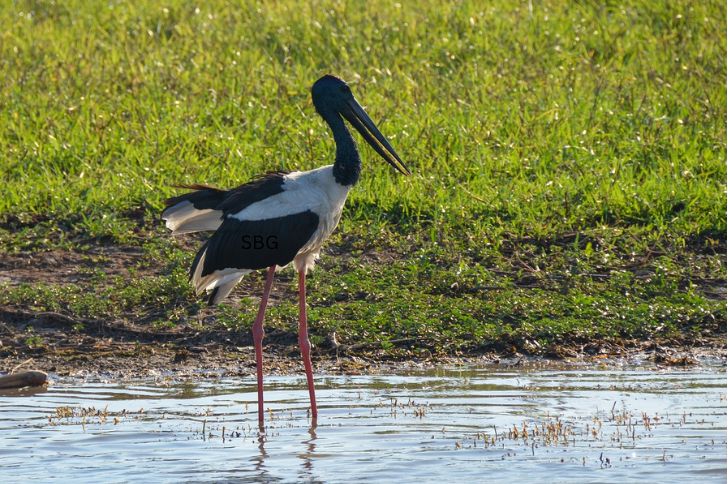
The black-necked stork is a large wading bird in the stork family. It is a widespread species in the Old World, occurring in much of Australasia.
Identification:
The adult black-necked stork has a wingspan of 91 inches and is 51-59 inches long from beak to tail. The body plumage is predominantly white with glossy black on the wings, back, and neck. The head is bear with a long dark bill and the legs are also red.
Sexes are similar except and juveniles are browner above with some buff on the underparts.
13. Black-Crowned Cranes
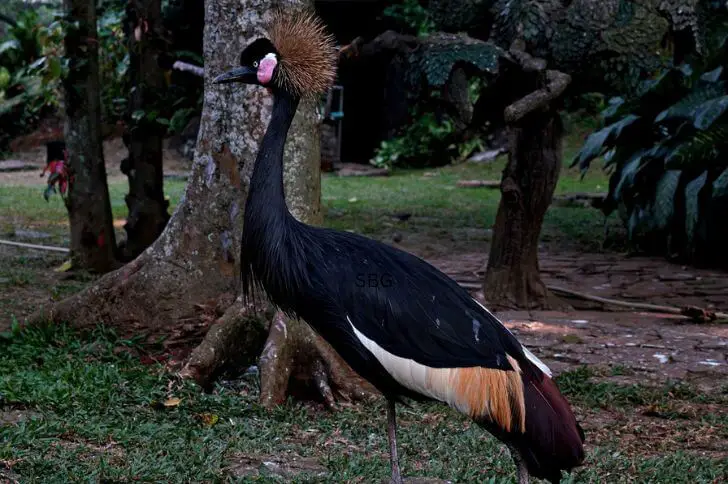
Another tall bird with a long neck is the black crowned crane. It calls Sub-Saharan Africa home.
Identification:
It is a long-necked, red-cheeked crane with a golden crown. The rest of its body is black. Note the white and silver feathers on its back. This tall bird spans up to 6.7 inches.
Other facts:
The black crowned crane is a symbol of good luck in many African cultures. It lives in wetland habitats and feeds on frogs, lizards, insects, and small mammals. This black long necked bird builds its nest in trees or bushes near water. The crane lays two to three eggs at a time. Both adults incubate the eggs.
The black crowned crane is endangered due to habitat loss and hunting. Cranes are hunted for their meat and feathers. The destruction of wetlands has also greatly reduced the populations of these birds.
14. Turkey vulture

The turkey vulture is a large bird of prey that is found in North and South America. It is one of the most common vultures in the United States.
Identification:
The turkey vulture has a wingspan of up to six feet and a body length of up to four feet. It is dark brown or black with a red head.
Other facts:
The turkey vulture feeds on carrion and can often be seen near roadsides or in fields where there has been a recent animal death. It is an important part of the ecosystem as it helps to clean up carcasses that would otherwise decompose and release harmful gasses into the environment.
15. Hawaiian Coot
The Hawaiian coot, also known as the alae kea in Hawaiian, is a waterbird endemic to the Hawaiian Islands.
Identification:
The bird is black with a white bill and red eyes. It is related to the American coot, but it is not as well-known. Adults are 13-16 inches in length.
Other facts:
The Hawaiian coot is found in freshwater wetlands on all of the main islands. It was once common, but its population has declined due to habitat loss and introduced predators. The largest populations of Hawaiian coots are now found on Kauai. Also check some of the other Kauai birds.
16. Black Curassow
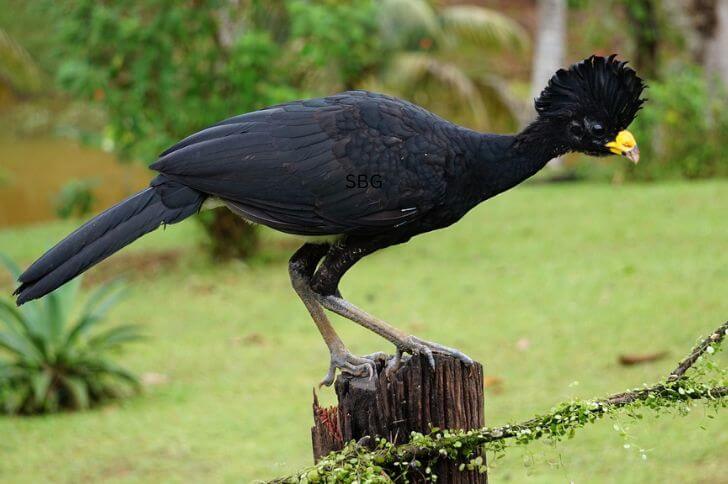
Black curassows are a species of bird that is native to the Amazon rainforest. They are fairly common within their range.
Identification:
Sexes are similar. The bird is known for its black plumage, yellow bill and curly head feathers. It is one the largest members of the curassow family, measuring about 35 inches in length.
Interesting facts:
The black curassow plays an important role in the rainforest ecosystem. The bird disperses seeds through its droppings, which helps to maintain the forest’s health. The black curassow is also a source of food for many animals in the rainforest.
17. Black Guan
Measuring 24.4-27.1 inches in length, the black guan is a species of bird in the Cracidae family. It is found in humid forests in Costa Rica and Panama.
Identification:
It is a plump bird with a short tail and legs. It has a black plumage with blue face and stunning red eyes. Note the long tail.
The black guan feeds on fruits, seeds, and insects. It nests in tree cavities and lays two to four eggs at a time. The black guan is considered to be of least concern for conservation due to its wide range and stable population.
Final Thought on black birds with long necks
From the North American Muscovy ducks to the African black crowned cranes to the South American black curassow, there are numerous black birds with long necks. In this article we discuss their unique body features and other important things such as breeding habits.
Sources:
https://en.wikipedia.org/wiki/Black_swan
https://www.audubon.org/field-guide/bird/muscovy-duck
Hi fellow bird watcher. Welcome to our small corner of the world. At the spanishbirdguides.com our mission is to share with other bird watchers the things we love about birds, where to go bird watching within the United States, and more. I’d also love to hear from you. Feel free to contact me about your bird watching escapades, share videos, photos and more.
